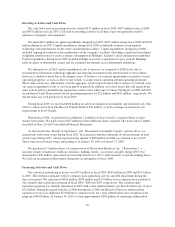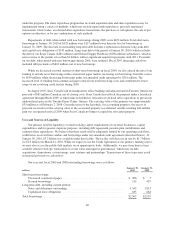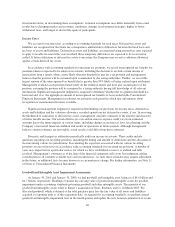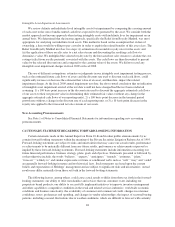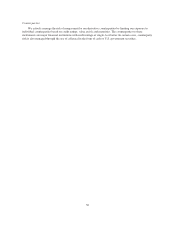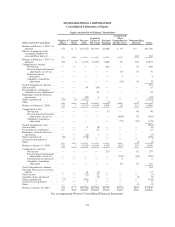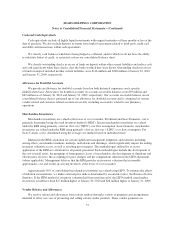Sears 2009 Annual Report Download - page 48
Download and view the complete annual report
Please find page 48 of the 2009 Sears annual report below. You can navigate through the pages in the report by either clicking on the pages listed below, or by using the keyword search tool below to find specific information within the annual report.Intangible Asset Impairment Assessments
We review definite and indefinite-lived intangible assets for impairment by comparing the carrying amount
of each asset to the sum of undiscounted cash flows expected to be generated by the asset. We consider both the
market approach and income approach when testing intangible assets with indefinite lives for impairment on an
annual basis. We determined that the income approach, specifically the Relief from Royalty Method, was most
appropriate for analyzing our indefinite-lived assets. This method is based on the assumption that, in lieu of
ownership, a firm would be willing to pay a royalty in order to exploit the related benefits of this asset class. The
Relief from Royalty Method involves two steps: (i) estimation of reasonable royalty rates for the assets and
(ii) the application of these royalty rates to a net sales stream and discounting the resulting cash flows to
determine a value. We multiplied the selected royalty rate by the forecasted net sales stream to calculate the cost
savings (relief from royalty payment) associated with the assets. The cash flows are then discounted to present
value by the selected discount rate and compared to the carrying value of the assets. We did not record any
intangible asset impairment charges in fiscal 2009 or fiscal 2008.
The use of different assumptions, estimates or judgments in our intangible asset impairment testing process,
such as the estimated future cash flows of assets and the discount rate used to discount such cash flows, could
significantly increase or decrease the estimated fair value of an asset, and therefore, impact the related
impairment charge. At the fiscal 2009 annual impairment test date, the above-noted conclusion that no indication
of intangible asset impairment existed at the test date would not have changed had the test been conducted
assuming: 1) a 100 basis point increase in the discount rate used to discount the aggregate estimated cash flows
of our assets to their net present value in determining their estimated fair values (without any change in the
aggregate estimated cash flows of our reporting units), 2) a 100 basis point decrease in the terminal period
growth rate without a change in the discount rate of each reporting unit, or 3) a 10 basis point decrease in the
royalty rate applied to the forecasted net sales stream of our assets.
New Accounting Pronouncements
See Note 1 of Notes to Consolidated Financial Statements for information regarding new accounting
pronouncements.
CAUTIONARY STATEMENT REGARDING FORWARD-LOOKING INFORMATION
Certain statements made in this Annual Report on Form 10-K and in other public announcements by us
contain forward-looking statements within the meaning of the Private Securities Litigation Reform Act of 1995.
Forward-looking statements are subject to risks and uncertainties that may cause our actual results, performance
or achievements to be materially different from any future results, performance or achievements expressed or
implied by these forward-looking statements. Forward-looking statements include information concerning our
future financial performance, business strategy, plans, goals and objectives. Statements preceded or followed by,
or that otherwise include, the words “believes,” “expects,” “anticipates,” “intends,” “estimates,” “plans,”
“forecast,” “is likely to” and similar expressions or future or conditional verbs such as “will,” “may” and “could”
are generally forward-looking in nature and not historical facts. Such statements are based upon the current
beliefs and expectations of Holdings’ management and are subject to significant risks and uncertainties. Actual
results may differ materially from those set forth in the forward-looking statements.
The following factors, among others, could cause actual results to differ from those set forth in the forward-
looking statements: our ability to offer merchandise and services that our customers want, including our
proprietary brand products; our ability to successfully implement initiatives to improve inventory management
and other capabilities; competitive conditions in the retail and related services industries; worldwide economic
conditions and business uncertainty, the availability of consumer and commercial credit, changes in consumer
confidence, tastes, preferences and spending, and changes in vendor relationships; the impact of seasonal buying
patterns, including seasonal fluctuations due to weather conditions, which are difficult to forecast with certainty;
48



